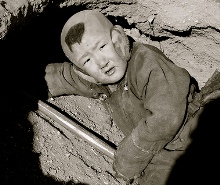Mongolian Buddhists and Development
 |
 |
 |
The nomadic way of life and the environment are threatened by mining in Mongolia. Photo from www.flickr.com/
|
The following information has been extracted from the
Mongolian Buddhists Protecting Nature Handbook which can be downloaded in English and in Mongolian.
Any location in Mongolia designated for the development of a building, settlement, temple, burial
site or nomadic camp was traditionally selected according to the special characteristics
of the site. Besides fulfilling practical needs such as water and fuel, the site must
be chosen in accordance with the instructions contained in Tibetan and Mongolian
sutras. The sutras determine whether a site has “good” or “bad” properties. These
characteristics relate mostly to the practicalities of setting up residence and refer to
the quality of the soil, of the wood, of the flora, etc.
Although most companies carrying out land development projects today now generally
choose the location for their development activities without referring to such religious
texts, some 80 percent do nonetheless still consult monasteries to enquire about
auspicious start dates for their projects and to request the monastery to conduct
ceremonies around the laying of foundations or the launch of a new project. N.
Batsaikhan at Dashchoilin Monastery believes that more and more mining companies
have been consulting them recently because company profits are decreasing and
because families in the area are perceived to be experiencing harm from pollution
and other similar causes. When such ill fortune is diagnosed as the result of having
angered the local spirit masters, appeasement ceremonies with offerings must be
conducted.
From the Buddhist point of view, any form of development that affects the land is
negative – especially mining – but the most important thing is that the land is later
allowed to regenerate. This is the responsibility of the companies concerned. “When
companies carry out mining for example they should then help the land to recover
and give offerings and prayers to the related ovoo,” says N. Batsaikhan.
In summary, it is important when carrying out any form of development in Mongolia
to bear in mind not only the environmental impacts but also ancient traditions, and
also to avoid both destroying ovoos and developing areas that are considered
sacred.
Where development is carried out, it is in accordance with present-day customs
to ask monasteries to conduct ceremonies to mitigate damage. From a Buddhist
perspective everything is interrelated: good company practice will bring profits and
happiness, bad company practice will bring suffering. And according to the laws of
karma, mitigating negative impacts on the surrounding environment and the life it
sustains are the responsibilities of the company that created them.
Pages about Mongolian Environmental Wisdom, taken from the Handbook.
The Mongolian Lord of Nature.
Sacred texts, places and ovoos.
Sacred sites
in Mongolia.
Traditional Environmental Law in Mongolia.
The work that the monks, in conjunction with ARC and the World Bank and others, are carrying out to rediscover the sutras about sacred land in Mongolia.
Do you want to support this?
For full contact and address details of Mongolian Buddhist Monasteries, please see page 57 of the
Handbook. And for details of local Development, Environmental and Educational NGOs, please visit pages 58-59 of the
Handbook.
Other links to Mongolian Buddhism and the Environment
Link here to access the news story about the launch of the Mongolian Buddhist Handbook.
Link
here to download the Mongolian Buddhist Handbook in English. (Please note this file is 1.15MB)
Link
here to download the Mongolian version of the Handbook.(A 2MB file.)
Link here to download the guide to the Mongolian Buddhists’ Eight Year Plan (this file is 4.13MB).
Link to Mongolian Case Studies.
And
here on how to make contact with the Sangha.
To download the A3 poster of a new thangka about Buddhists protecting Nature, link
here (5.61MB).
Brief History of Mongolian Buddhism.
Buddhism and the Environment.
Women in Buddhism in Mongolia.
Key Figures in Mongolian Buddhism.
Key Meetings in Mongolia.
Mongolian Buddhists and Development.
Mongolian Buddhists and Ecology.
Mongolian Buddhist Hunting Ban.
The Lost Sutras.
|

